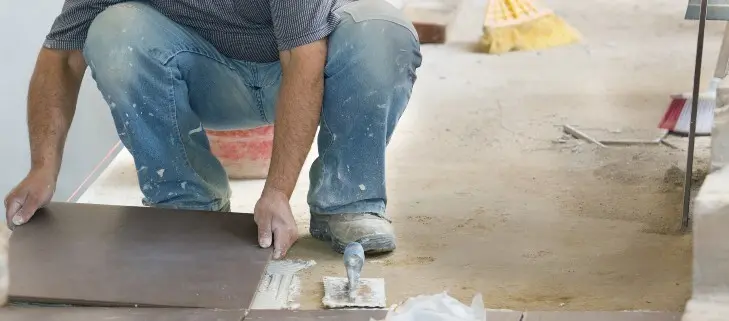Have you ever wondered about the perfect thickness for tile adhesive? Ensuring the right amount of adhesive under your tiles is crucial for a successful installation, but the ideal thickness can vary depending on several factors. Also Read Manufacturers of Tile Adhesive, Wall Putty & Epoxy Grout
Whether you are a seasoned tile installer or a DIY enthusiast, understanding the nuances of tile adhesive thickness is key to achieving a professional finish. Let’s explore the considerations that come into play when determining how thick your tile adhesive should be and why it matters.

Factors Influencing Tile Adhesive Thickness
- When determining the appropriate thickness for tile adhesive, factors such as the type of tile, substrate condition, and desired bond strength must be carefully considered. The type of tile plays a crucial role in determining the thickness of the adhesive.
- Porous tiles, like natural stone or terracotta, require a thicker layer of adhesive to ensure proper bonding due to their uneven surface texture. On the other hand, non-porous tiles, such as ceramic or porcelain, may need a thinner layer for effective adhesion.
- Substrate condition is another vital factor. A flat and smooth substrate allows for a more even application of adhesive, requiring less thickness. In contrast, uneven or rough surfaces necessitate a thicker layer to compensate for irregularities and ensure a strong bond. Additionally, the desired bond strength influences the adhesive thickness. Higher bond strength requirements may call for a thicker adhesive layer to enhance the overall durability and longevity of the tile installation.
- Application techniques also impact the thickness of the adhesive. Proper trowel selection and technique can help achieve the desired adhesive thickness consistently across the installation area. By considering these factors and utilizing appropriate application techniques, you can ensure the optimal thickness of tile adhesive for your specific project.
Recommended Thickness for Different Tiles
How should the thickness of tile adhesive vary for different types of tiles to ensure optimal bonding and installation durability?
- When working with tiles of varying sizes, such as larger tiles, it’s recommended to apply a thicker layer of adhesive to accommodate any unevenness in the substrate and provide better support. For smaller tiles, a thinner layer is sufficient to prevent excess adhesive from squeezing through the grout lines during installation.
- The type of tile being used also plays a crucial role in determining the adhesive thickness. Porous tiles, like natural stone, may require a thicker adhesive layer to ensure proper adhesion, while non-porous tiles, such as ceramic or porcelain, can typically bond well with a standard thickness.
- Additionally, the grout color can influence the adhesive thickness needed. Light-colored grout may require a more precise installation technique to prevent adhesive from discoloring the grout lines, whereas darker grout colors are more forgiving.
Adjusting Adhesive Thickness for Substrates
- Adjusting the thickness of tile adhesive for substrates requires careful consideration of the substrate’s condition and characteristics to ensure proper bonding and structural integrity. Substrate compatibility is a crucial factor when determining the appropriate adhesive thickness. Before application, assess the substrate material, porosity, flatness, and any existing coatings or treatments that may affect adhesion.
- For substrates that are highly porous or uneven, a thicker layer of adhesive is often necessary to fill gaps and create a level surface for the tiles. In contrast, smoother substrates may require a thinner adhesive layer to prevent slippage and ensure a strong bond. When dealing with substrates that are prone to movement or moisture exposure, choosing a flexible adhesive and adjusting the thickness accordingly can help accommodate these conditions and prevent tile damage over time.
- Application techniques also play a significant role in adjusting adhesive thickness for substrates. Proper trowel selection and technique can help achieve the desired adhesive coverage and thickness, ensuring optimal tile adhesion and durability. Experiment with different trowel sizes and angles to find the most suitable application method for the specific substrate you’re working with.
Importance of Consistent Adhesive Thickness
- To ensure the optimal performance and longevity of your tile installation, maintaining a consistent adhesive thickness is paramount, particularly after considering the substrate’s characteristics for proper adhesion and structural integrity. Application techniques play a crucial role in achieving this consistency.
- When applying tile adhesive, using the appropriate trowel size and technique is essential. Ensure that the trowel ridges are of uniform height to guarantee consistent coverage and prevent uneven tile setting. Inadequate adhesive coverage due to inconsistent thickness can lead to tile slippage, breakage, or poor bonding over time.
- Consistent adhesive thickness is also vital for the overall aesthetic appeal of your tiled surface. Varying adhesive thickness can cause tiles to sit unevenly, resulting in an unprofessional finish. Additionally, a uniform adhesive layer helps distribute weight evenly across the tiles, reducing the risk of cracks or delamination. By adhering to proper application techniques and ensuring consistent adhesive coverage, you can enhance the durability, stability, and visual appeal of your tile installation.
Tips for Achieving Optimal Adhesive Thickness
- For achieving optimal adhesive thickness, ensure that the trowel you select matches the tile size and material for consistent coverage and secure bonding. Using the right trowel size is crucial in achieving consistency in adhesive thickness. Make sure to check the manufacturer’s recommendations for the correct trowel size based on the tile dimensions and material.
- When applying the adhesive, hold the trowel at a consistent angle to the surface to ensure even distribution. Avoid pressing too hard or too lightly, as this can lead to inconsistent adhesive thickness. If you notice areas where the adhesive seems too thin or too thick, stop the application and adjust your technique immediately.
- Troubleshooting problems related to adhesive thickness can often be traced back to improper trowel selection or application technique. Always double-check that the trowel matches the tile specifications and adjust your method if needed. By paying attention to these details and making necessary adjustments, you can achieve the optimal adhesive thickness for a successful tile installation.
Conclusion
Ensure your tile adhesive is the right thickness for a successful installation. Factors like tile type and substrate play a crucial role in determining the ideal adhesive thickness.
Consistency is key to achieving a strong bond and preventing future issues. Follow manufacturer recommendations and adjust as needed to ensure your tiles stay in place for years to come. With the right adhesive thickness, you can create a durable and beautiful tile surface in no time.


